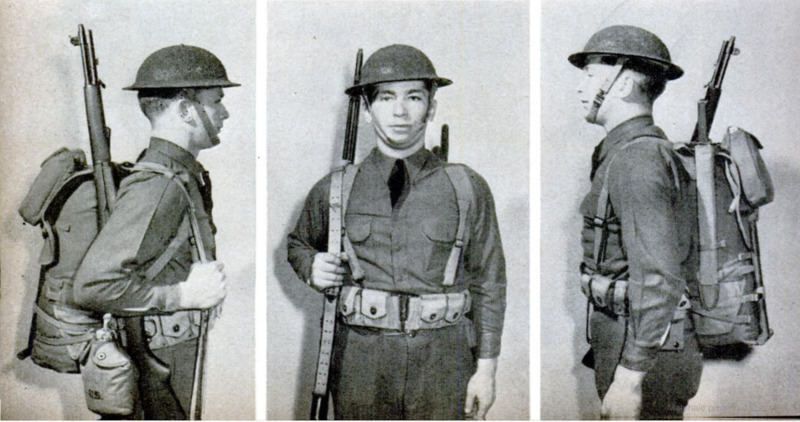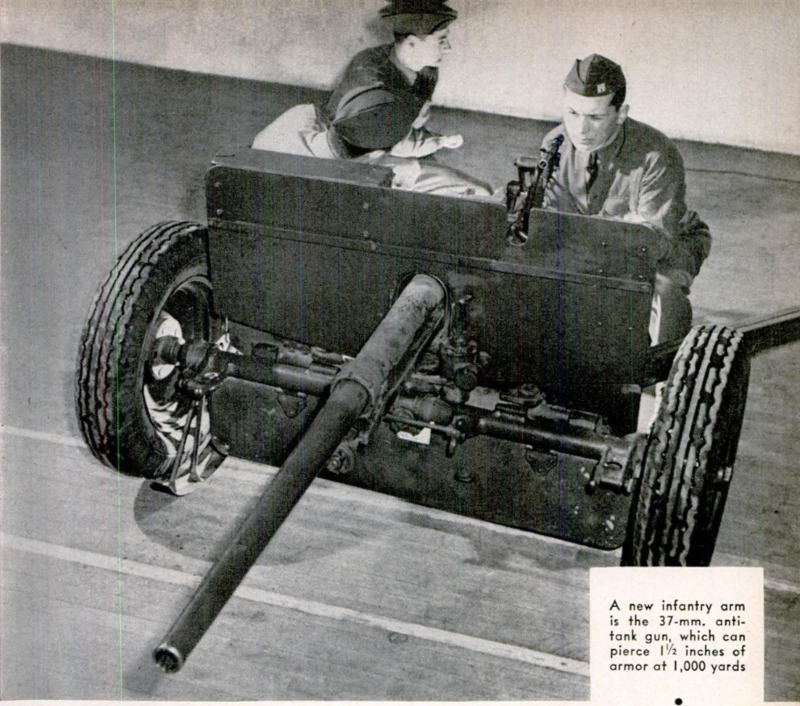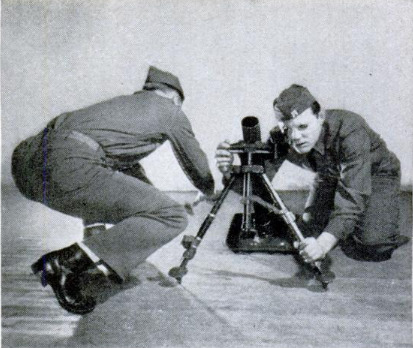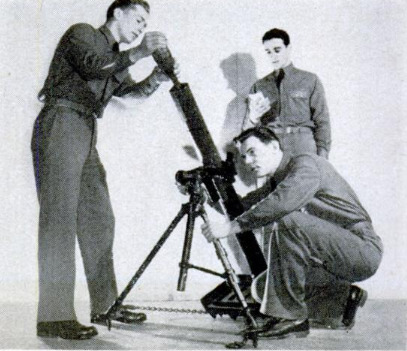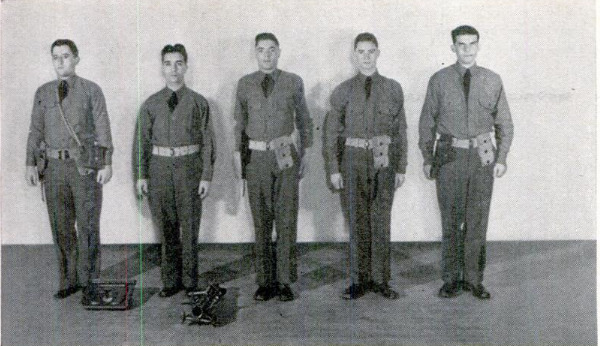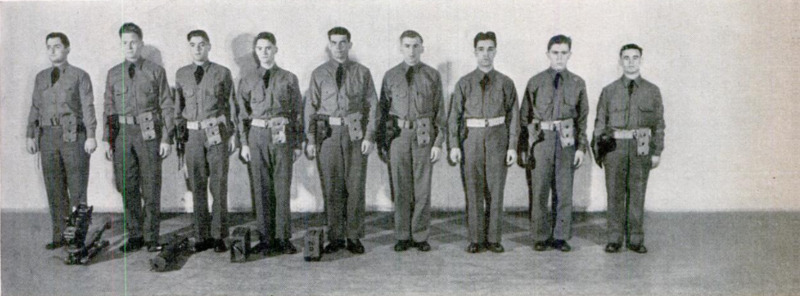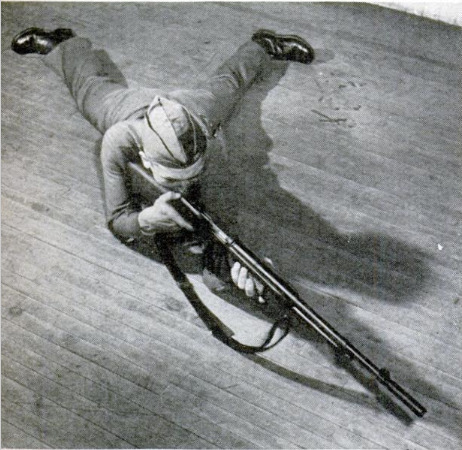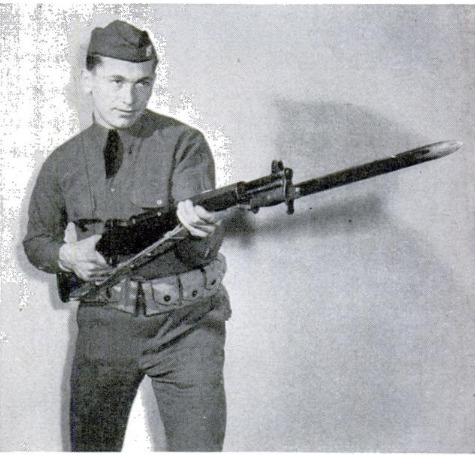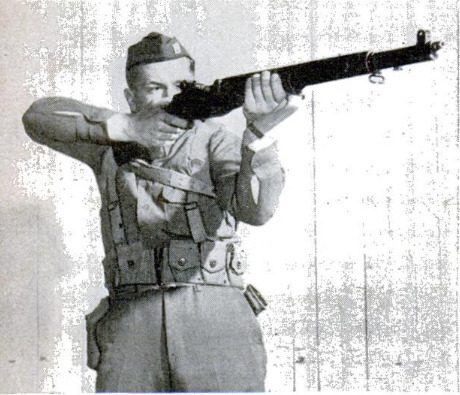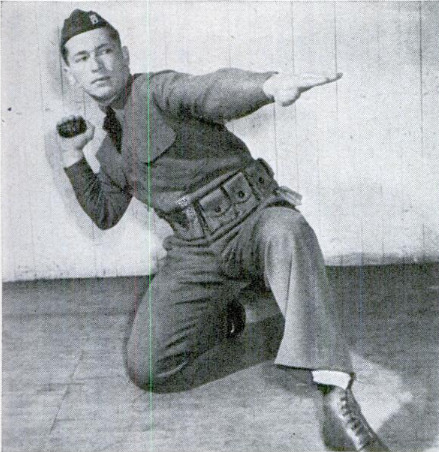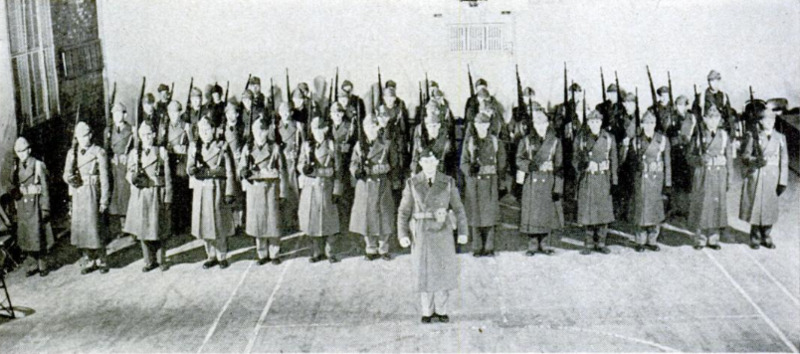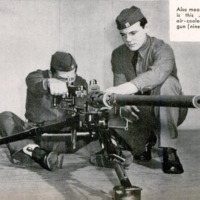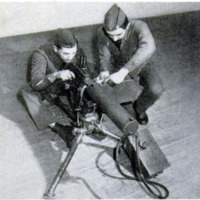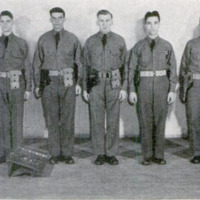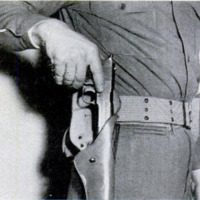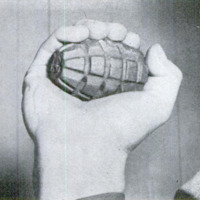-
Title (Dublin Core)
-
Infantry's new weapons give fire power and punch
-
Article Title and/or Image Caption (Dublin Core)
-
Title: Infantry's new weapons give fire power and punch
-
extracted text (Extract Text)
-
ONE DAY in 1941 Dick Brown, aver-
age young American, sound of body,
alert of mind, answers the call of his
country to become part of its combat man-
power, and is assigned to the infantry.
Dick's father, let us say, was an infantry-
man 24 years ago, in that other great call to
arms, but Richard, Sr., would find it difficult
to recognize the infantry into which his son
is inducted. For the modern infantry is no
more like that of World War days than the
rhumba is like the 1917 shimmy dance.
In the 1941 infantry, Dick may become a
rifleman, in which case he will use a Garand
semiautomatic rifle instead of the Spring-
field .30 with which his father fought. Or he
may become part of an automatic-rifie
squad, whose weapon is a .30 caliber Brown-
ing automatic rifle which can be fired with
or without a mount.
Or he may become a member of a weapons
platoon and be trained in the use of an air-
cooled .30 caliber Browning light machine
gun, and a 60-mm. mortar, which looks like
a toy—a toy that can lob three and a half
pounds of explosive death to a maximum
useful range of 1,900 yards.
Or Dick may become a member of a
heavy-weapons company which uses a .30
caliber Browning heavy machine gun, wa-
ter-cooled, and an 81-mm. mortar that
throws a light seven-pound explosive shell
to a maximum useful range of 2,000 yards,
a medium ten-pound shell somewhat less, or
a heavy shell to a maximum useful range of
1,500 yards; and a .50 caliber antitank ma-
chine gun.
And finally Dick may be assigned to a
modern antitank company. In this case he
will be trained to serve a 37-mm. antitank
gun, a comparatively new fieldpiece that
fires a high-explosive shell with an armor-
piercing capacity of one and a half inches of
armor plate at 1,000 yards.
As an infantryman in any special capac-
ity, such, for example, as a messenger at-
tached to a platoon, or as part of an auto-
matic-rifle squad or a machine-gun section,
and so on, Dick will wear as a side arm a
.45 caliber Colt automatic pistol. As a rifle-
man his only side arm will be the bayonet,
for the thrust of cold steel in individual com-
bat remains, despite all modern develop-
ments, a basic form of infantry training.
Hand grenades also constitute a part of
Dick's basic training as an infantryman.
In the U. S. Army grenades are shaped
somewhat like small pineapples. If Dick has
ever played football, throwing grenades will
be easy. When Richard, Sr., was taught to
throw grenades he held his arm stiff a little
in back of his body and threw the grenade
in a stiff-arm overhead motion. Dick cocks
his hand at his shoulder and throws as if he
were throwing a football.
All infantrymen, no matter to what special
unit they eventually are assigned, are
trained in the use of the rifle, bayonet, and
grenade. And under the new training set-up,
Just now being established, all infantrymen
will receive general training in most of the
other infantry weapons as well, as a prelude
to extensive, specialized training in the units
to which they are finally attached.
The new training set-up is based on the
establishment of so-called replacement cen-
ters for all branches of the Army. The in-
fantry replacement centers have been con-
structed at Camp Roberts, San Miguel,
Calif.; Camp Wolters, Mineral Wells, Tex.;
Camp Wheeler, Macon, Ga.; and Camp
Croft, Spartanburg, S. C.
‘Under this new plan, Dick, when he is in-
ducted, is sent to one of these centers. There
he receives 13 weeks of basic infantry train-
ing. These centers actually become vast
training reservoirs to which division or reg-
imental commanders send requisitions for
men to fill vacancies in their outfits. At the
end of his 13 weeks, Dick joins the tactical
unit to which he is assigned, already trained
in the fundamentals of a soldier and ready
for more advanced training. When the new
plan gets into full operation it will resemble
an automobile assembly line applied to man-
power.
The first combat unit with which Dick be-
comes associated is the squad—and here be-
gins the difference between the composition
of the modern infantry and that of 1917.
When Richard, Sr., became a fighting man
the rifle squad consisted of eight men. They
formed in double rank of fours and the man
on the right of the front rank was the cor-
poral, the squad commander.
The modern rifle squad consists of 12 men.
Ten are privates, one is a corporal—now
second in command—and the leader is a
sergeant. Instead of the double formation
the men line up in single rank, with the ser-
geant at the extreme right, the corporal at
the extreme left.
The modern infantry platoon is composed
of three rifle squads, an automatic-rifle
squad, and a platoon headquarters group.
The sutomatic-rifle sauad consists of eight
men: a squad leader, an assistant, two rifle
men, two assistant riflemen, and two am-
munition carriers. The platoon headquarters
is composed of a second lieutenant, com-
manding the platoon, two sergeants, two
messengers, and five privates. Basically
there are 53 men and one officer in a modern
platoon.
Tt is only a rifle squad that has a full
strength of 12 men. The various weapons
squads, such as the automatic-rifle squad,
are composed of only five to nine men.
, These squads break down as follows: .30
Caliber light machine gun, five men—cor-
poral, gunner, assistant gunner, and two
ammunition bearers; 60-mm. mortar, five
men—corporal, who Is also the gunner, an
assistant gunner, and three ammunition car-
riers; .30 caliber heavy machine gun, nine
men—corporal, gunner, assistant gunner,
five ammunition carriers, and a chauffeur;
81-mm. mortar, nine men—same set-up as
heavy machine gun; 37-mm. antitank gun,
five men; .50 caliber machine gun, nine
men.
Advancing now from a platoon to a com-
pany we find that the 1941 infantry com-
pany is composed of three rifle platoons and
—to the bewilderment of Richard, Sr.—a
weapons platoon. The weapons platoon is to
a company what the automatic-rifie squad
is to a platoon.
The weapons platoon comprises a com-
mand group, one 60-mm. mortar squad, and
one .30 caliber light machine-gun squad.
The mortar squad has three mortars, the
machine-gun squad has two machine guns.
The mortars are used for blasting out enemy
machine-gun nests, the light machine gun
for the close support of small rifle units by
flanking fire, Both mortars and machine
guns are moved in motor carriers, and each
of the sections carries an automatic rifle for
antiaircraft fire. There are messengers at-
tached to rifle and weapons sections,
The modern company, which includes a
headquarters group as well as the rifle and
weapons platoons, is composed of 217 men
and six officers, as compared with 250 men
of the old company. It is designed for flex-
ibility, speed, mobility, and striking power,
and the same design extends from the com-
pany into the modern infantry battalion.
Just as an infantry company has a weapons
platoon, so an infantry battalion has a
weapons company. There are three rifle
companies in a modern battalion and one
heavy-weapons company.
The weapons company is equipped with
.30 heavy machine guns, .50 machine guns,
and 81-mm. mortars. All these weapons are
also carried by motor transport. A sure way
to tell whether an infantryman is in a rifle
company or a weapons company is by the
letters with which the companies are desig-
nated. Every fourth letter indicates a wed-
pons company. For example, Companies A,
B, and C of a battalion are rifle companies;
Combany D is 8 Weapons company.
In the modern infantry there are now lo
companies to a regiment, rather than 14 as
when Richard, Sr., was a soldier. The extra
company is an antitank company, armed
with 37-mm. antitank guns. That is, there
are three battalions of four companies each
to a regiment. That makes 12 companies.
A headquarters company and a service com-
pany make 14, and the antitank company
completes the regiment formation. Two
hundred and forty-four vehicles—sedans,
motor cycles, trucks, and trailers—form the
motorized equipment for the modern in-
fantry regiment.
The Regular Army division is now tri-
angular, rather than square as it was when
Richard, Sr., was in the A.E.F. That is, there
are three regiments in each of the nine Reg-
ular Army divisions, instead of four regi-
ments to a division. The reason for this
once again is the insistence on speed, mo-
bility, and striking power. The 18 Na-
tional Guard divisions, however, still retain
the old four-regiment composition.
Simplicity has been extended to close-
order formations and drill for the new in-
fantry rifle squads, platoons, and companies.
There are no more commands such as
“Squads right!" “Squads left!" or the more
oblique movements, “On right into line!"
and so forth. The squads now line up in
single rank, one behind the other until they
are three deep. The command to bring
them into column marching order is “Right
face! Shoulder arms! Forward march!” or
“Left face” and so on. It sometimes took
two weeks to teach & squad the simplest of
the old-time commands. Now a squad can
be taught the fundamentals of drill in one
tenth the time.
‘The differences between the infantry which
Richard, Sr., knew and that into which Dick
is inducted extend even to clothing and the
welght of the pack a man carries. Richard,
Sr., wore a_choke-collar coat and his lower
legs were incased in spiral leggings that
often were wrapped so tightly that a man
would keel over on the march from lack of
circulation. (They even killed the hair roots.
on the calves of the legs.) Richard, Sr.
lugged 90 pounds of equipment on the march.
Dick wears a comfortable, attractive lapel
coat and long trousers. When he is in the
field the trousers are tucked into canvas leg-
gings. His equipment weighs 57 pounds, 33
less than his father carried, and yet in-
cludes all the necessary articles: a blanket,
tent pole, tent pegs, half of a shelter tent
(the other half Is carried by his tent part-
ner), tent rope, extra underwear, socks and
handkerchief, toilet articles, mess gear, ra-
tions, first-aid pouch, ammunition belt, hel-
met, rile, canteen, bayonet, and—this is
very important in modern combat—an in-
trenching tool, which may be a small shovel,
a small ax, or a pick-mattock. His corporal
or sergeant also will carry wire clippers.
Dick's pack is so ingeniously constructed
that when he goes into action he jerks a
strap and the equipment he will not need
drops to the ground, leaving him only 18
pounds to carry. Besides his weapons and
‘ammunition belt, carrying ten clips of eight
rounds each of cartridges, this includes his
intrenching tool, mess gear, and rations.
‘After Dick has learned the fundamentals,
he till has far to go. He must learn the art
of camouflage. He must learn to read maps,
£0 travel by compass, or to use hia watch and |
the sun in place of a compass, and to orient
himeelf at night by means of the stars. He
is taught to recognize the whine or shriek of
an artillery shell and to sense the prox-
imity of the burst. He is taught to identify
the fire of small arms and to locate the |
origin of fire of small arma from the sound
of the discharge Instead of, incorrectly, the
Crack that bullets make when they are al-
ready in fight.
He in taught how to use his intrenching
tools to scoop out a hollow for himself in the
earth. He 1s taught how to advance In com-
bat, by rushing forward and then throwing
himself to the ground, taking advantage of
the shape and color of the ground and back-
ground. He fs taught how to advance behind
tanks, how to Aight in a clump of woods, how
to move cautiously through a village. For
modern warfare fa not the trench Warfare
that Richard, Sr., knew. Modern warfare
has returned to the classic conception. It 18
warfare in the open, In the fel, in woods, In
villages; quick, short thrusts, and when the
final surge forward comes Dick is virtually
on hia own, and therefore he must be trained
not only In discipline but als in initiative.
For when the big guns have spoken, the
tanks have rumbled and spa fire, the planes
have dumped their bombs, the machine guns
have chattered, and the mortars have curved
their loads of destruction against enemy
emplacements, It Is Dick Brown, modern
rifleman, Who places the final stamp of vie-
tory on & military operation. |
-
Contributor (Dublin Core)
-
John Watson (article writer)
-
Language (Dublin Core)
-
Eng
-
Date Issued (Dublin Core)
-
1941-05
-
pages (Bibliographic Ontology)
-
64-70
-
Rights (Dublin Core)
-
Public domain
-
Archived by (Dublin Core)
-
Sami Akbiyik
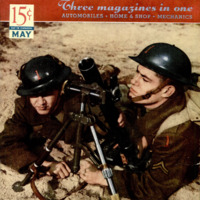 Popular Science Monthly, v. 138, n. 5, 1941
Popular Science Monthly, v. 138, n. 5, 1941

